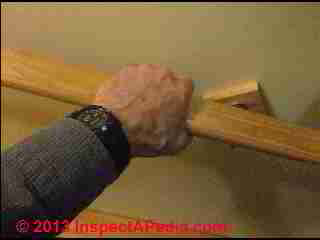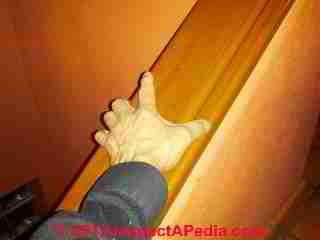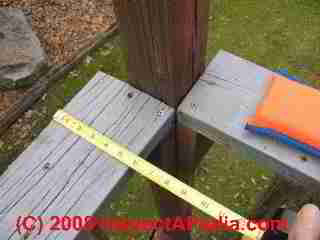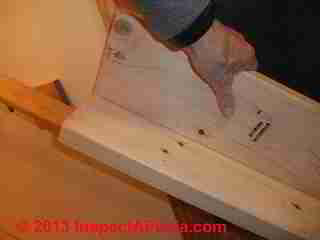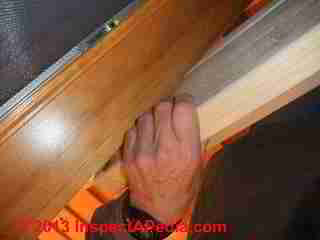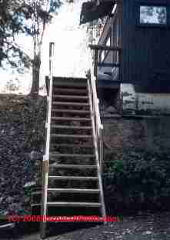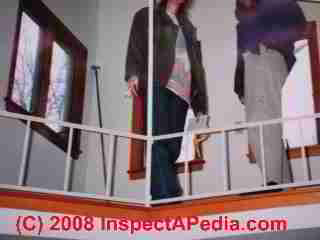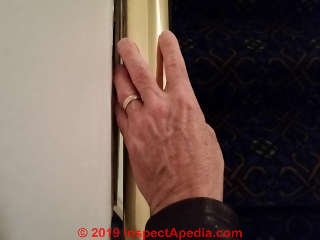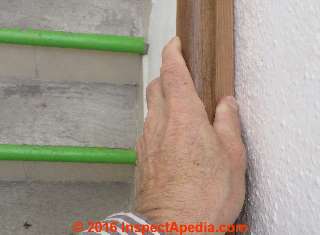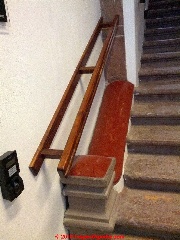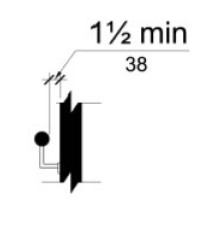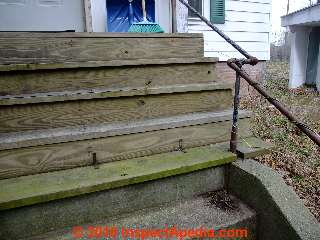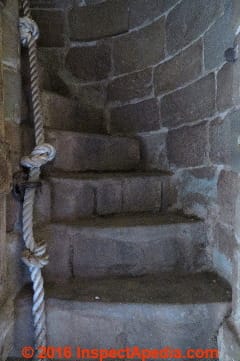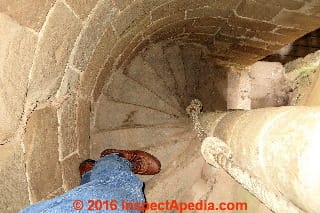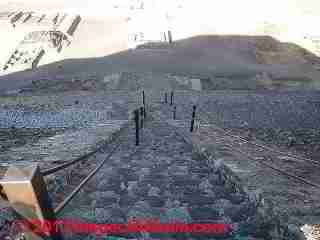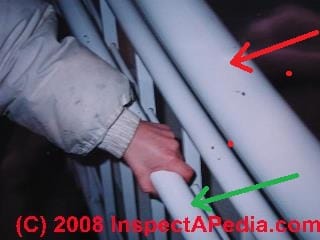 Handrailing Graspability Defects & Photos
Handrailing Graspability Defects & Photos
Illustrations of handrails that are unsafe because they can't be grasped
- POST a QUESTION or COMMENT on the graspability or hand-hold capability of building handrails
Handrailing graspability defects:
This article illustrates several categories of handrailing graspability defects, all of which make a stairway unsafe. Some of these include a handrail whose profile is too wide or whose dimensions are too big for the hand to grasp, while others include using 2x lumber, a handrail that is too low or too high, or a handrail that is not spaced properly away from a building wall. All of these conditions can contribute to a fall and to an injury along a stairway.
This article series explains and illustrate the requirements for graspable handrails & railings used inside or outside buildings, including guardrails, hand railings on steps and stairs, and stair rails or stair guards for both interior and exterior stairways. used on stairs, balconies, decks, ramps, walks.
We include descriptions & definitions of graspability for handrailings, and we illustrate safe and unsafe, graspable and not-graspable handrailings in sketches, photographs, and building code citations.
These stair and railing articles provide building code specifications, sketches, photographs, and examples of stair & railing safety defects used in inspecting indoor or outdoor stair railings or handrails and related conditions for safety and proper construction.
InspectAPedia tolerates no conflicts of interest. We have no relationship with advertisers, products, or services discussed at this website.
Stair Handrail Dimensions & Shape - A Photo Guide to Unsafe & Unacceptable Handrails & Stair Railings
Article Contents
- HANDRAIL GRASPABILITY DEFECT PHOTOS - Photos & Examples of Unsafe Un-Graspable Handrails
- HANDRAILING is TOO WIDE or BIG to grasp
- HANDRAILING uses 2x LUMBER and is not graspable
- HANDRAILING is TOO LOW
- HANDRAILING is TOO CLOSE to WALL
- HANDRAILING TOO SMALL, LOOSE, ROPE HANDRAILS - are not reliable
Photo Example of Safe Handrailing Size & Shape for a Graspable Handrail
Above and just below our photographs illustrate a properly designed & installed graspable stair railing or handrail. From the under-side of the handrail you can see that when the railing is of a proper dimension and profile the hand can make a secure grasp.
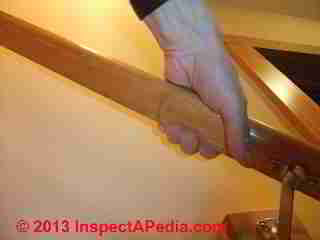
Hand railing that is too wide to grasp
The non-graspable2x lumber handrail photographs shown above illustrate two more "wide handrailing" hazards: the rail is far too large (a nominal 2x6-inch flat railing) to be grasped by the hand.
Handrailing that lacks a graspable thumb groove
In addition, where the railing abuts a vertical surface (my middle two fingers in the photo) the user cannot even latch fingers around the outside of the "railing" - making it virtually useless.
Note: a 2x4 or 2x6 or other lumber placed "on the flat" for use as the top of a guardrailing (used on level walking surfaces) does not normally raise these graspability issues.
See Guardrails on Balconies & Landings.
A too-wide handrail may be not-graspable even if it has thumb and finger grooves
The stair railing below is attractive but like the full-scale 2x6 railing above the rail below is still hard to grasp, even with thumb and finger grooves because it is just too wide.
An adult's hand can hold on with thumb and fingertips but a child could not grasp this rail and perhaps not an elderly person and probably no one at the onset of a fall.
Click to enlarge any image]
At that point in the fall, near its inception, the nearest hand goes out to try to grasp the railing. If the railing is "not there" because it is too low, too high, too far away, or if the railing is not properly supported and breaks away, or if the railing, as in your case, is improperly designed so that it is not possible to grasp, the hand slips away and the fall continues to its worst conclusion.
Therefore in my opinion, at a stair such as the one above, regardless of whether a person who fell accurately remembers exactly what happened to initiate the fall and regardless of whether or not the person recalls grasping for the rail, it is highly likely that s/he attempted to do so.
A non-graspable handrailing in this condition will deny the stairway any opportunity to arrest the fall, thus contributing greatly to the fall's extent and severity.
How do unsafe handrailings contribute to stair-fall injuries? "Handrails must provide an adequate handhold for [people] to grasp to prevent falls"
Unlike the easily-grasped handrail shown above, our stair handrail photograph above illustrates an attractive stainless-steel rail on a lower stairway in the New York City Metropolitan Opera building.
As you can see from our model's hand on top of the railing, the width of this particular rail, roughly 6", is too great to be grasped and held on-to should a stair fall occur. A 2x6" shape on edge, is also not readily graspable.
As we cited in OSHA's guidelines above, and as you will read in every expert source on proper stairway railing or "handrail" or "banister" design in our references at the end of this article, to be usable and functional, a handrailing must
- be of a size and shape than can be easily grasped,
- must be at the proper height above the steps (measured at the tread front nose),
- must be separated from the side wall (if present) at an adequate distance to permit the hand to grasp the railing, and
- must be continuous.
- And of course the railing must also be secured soundly to the structure.
If any of these features are violated the hand railing is unsafe. An unsafe handrailing may go unnoticed for a long time, even years. But an improperly designed or installed handrail is likely to be discovered, and will contribute to the extent of injuries suffered by someone who slips, trips, or falls when using the stairs.
A loose handrailing can actually contribute to or even be a root cause of the initiation of a stairfall. But even when the stair-fall occurs for some other reason, if the falling person cannot maintain a grasp on the railing, that person is likely to suffer more serious injuries than if s/he might have had the opportunity to use a grasp on the handrail to stop the fall or to reduce its extent.
Too Wide or Too Fat Handrails Cannot be Grasped When Falling
One of my daughters fell down these curved stairs at the Galleria shopping mall (Poughkeepsie, NY) where the triangular tread hazard was combined with a beautiful, architect-designed handrail that was about 8" in diameter (photo at left, red arrow) - she was unable to grasp it as she was falling.
The photo shows her older sister grasping an added handrail (green arrow) that appears to have been added on to correct this unsafe condition.
The original "fat" hand railing that no one could grasp when falling remains installed but we do not recommend relying on it.

Above we show photographs of more non-graspable handrails that are unsafe: at Carnegie Hall in New York City, and just above, demonstrated by Asta S. in San Miguel de Allende, Mexico. The "stair rail" above is not just too big, not graspable, it's also too low.
Handrails made out of 2x Lumber On-Flat are Usually Unsafe: Too Wide, and Not Grasp-able
Click to enlarge any image]
Handrail cross section and size specifications
One of the most frequent fall hazards we encounter are home-made railings that are too small or too large to grasp, or handrails that do not permit continuous grasping along their length.
A handrail made out of a 2x6 set flat and run along a stairway cannot be grasped.
Type II Residential Handrails - for perimeter larger than 6 1/4"
Some (not all) codes allow handrails that have an overall perimeter greater than 6 1/4", most commonly to permit use of 2x lumber to construct handrails. However in these larger sizes, the handrail must have a thumb and finger groove; Some older codes may permit the 2x6 handrail profile at far left in the illustration below, but as of 2009 the handrail needs a groove on both sides.
The intent of the finger and thumb groove is to provide equivalent graspability as might be obtained on a round 2-inch handrail. (The 2-inch handrail is allowed by all U.S. building codes.)

Watch out: No model building code and no other building code that we have surveyed permitted 2x6 or even 2x4 handrailings installed "on the flat" as a safe graspable stair handrail system. The two sketches here illustrate graspable (and X'd out non-graspable) handrailing profiles.
Reader Question: is a 2x6 handrailing safe and legal?
I fell using a handrail. It was a 2 by 6 piece of wood. Was this safety railing up to code in 1991? - Anon 8/20/12
Will a 2 by 6 pass code prior to 1991 to use as a safety railing ? - Anon
Reply: What are the Specifications for a Graspable 2x Hand Railing Along a Stair?
Anon, a 2x6 handrailing placed "on flat" and even a 2x4 handrailing in the vertical position if it lacks a thumb-groove (sketch above from the CBC [37] - click to enlarge) is not readily graspable, is not safe, and does not comply with the hand railing maximum perimeter rules in model building codes. Recapping from our article above in which we describe the shape and size parameters for stair handrails:
- Railing grip size and shape: (must be able to be grasped)
- Round rails: between 1.25" and 2" in diameter
- Metal ogee shaped: <= 2.25" across widest dimension
- Wood oblate shaped: <= 2.25" across widest dimension
- Rectangular shaped: perimeter must be between 4" and 6.25"
- Perimeter larger than 6" must have a graspable finger recess (see details at the ASM document link below)
That last item in our bulleted list means that code inspectors may approve a 2x6 or 2x4 hand railing placed in the vertical position (narrow dimension facing up - a width that can be readily grasped during a fall, while on flat it cannot - but the design needs to include a finger recess to permit a secure grip. Without that finger or thumb recess (seems to me it should be on both sides of the rail) the grasp is not secure.
Examples of Unsafe Non-Graspable Handrailings: examples of non-graspable 2x lumber handrails
The photographs above and below illustrate a non-graspable 2x6 wooden handrailing.
Above, the thumb is pressed against the vertical side of a 2x6, relying on friction alone for security - there is no mechanically-locking grasp of this railing - it is unsafe. Railings of this design are not approved by any of the model building codes.
In the next photo of this 2x6 "handrailing" of the same railing design you can see that the four fingers of the hand also must rely on friction alone, as there is no groove that might give a mechanical purchase, and certainly the wood rail is far too large to be grasped around by the hand.
These examples of mis-using 2x lumber as hand railings or stair railings are important because it is so common to find them on exterior stairways.
In short, as we demonstrate here, a simple 2x4 or 2x6, placed on edge along a stairway is not a graspable railing and so is not safe. It also will not comply with any of the model or actual building codes we cite above.
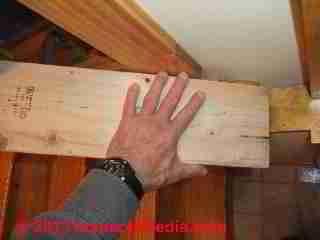
More Examples of 2x4" or 2x6 "Handrails" Set on Edge (or flat) & that are Unsafe
A handrail made out of a 2x6 set on edge and run along a stairway also cannot be grasped. The author along with Art Cady built this exterior stair in the 1970's. The stair railing is unsafe because
- Handrail not graspable: The simple 2x6 on-edge is too large to grasp
- The hand rail is not continuous: it is interrupted by the vertical 2x posts. - see HANDRAIL CONTINUITY
By giving up some stairway width it's easy to fix this problem by adding a round or similarly-profiled handrailing at the proper height and fixed to the sides of the 2x6 by using handrail brackets.
Some installers route a "thumb groove" into the sides of a 2x6 to make an attempt at improving graspability.
In our OPINION this remains an over-sized handrailing and even if approved by some inspectors, it is not as safe as one that can be grasped securely by wrapping the hand and fingers around the railing.
Your thumb and fingers simply cannot adequately encircle and hold securely on to such a hand rail. It may seem safe ... until the added forces of a slip, trip, or fall are added.
While a thumb groove may make it possible to obtain local building offical approval of the handrailing, try watching an elderly, frail person using the railing .She or he will lean on the railing but will not be able to grasp it adequately to arrest a fall - in my OPINION - DF.
A Handrail or Guardrail May be Too Low - and also not graspable along the stair
Click to enlarge any image]
It is surprising how many installations we find of guardrails that are so low as to be ... well, a joke. It's funny until somebody trips or steps backwards and falls over such a psuedo-guardrail such as the one shown in my photo.
Here is a quick list of related guardrail or railing safety SNAFUs:
- Railing wrong height on stairs (above) or landing (at left) - too low to grasp or too high to grasp, or too low to prevent falling off of a platform, as I'm demonstrating in the right-hand photo above and in the stair landing photo shown here.
- Railing loose, not properly secured (litigation photos)
- Railing missing
- Railing wrong dimension - cannot grasp; railing does not permit continuous grasping over length
Handrailing is Too Close to Wall - not graspable
We find a surprising number of handrailings that the installer must himself never have tried to grasp as they are so close to the wall that grasping is impossible.
Just hooking a few fingers over the lip of a too-tight-to-wall handrail is not going to arrest a fall. Below, the brass handrailing along the stairs of a New York City concert hall transition from the open side of a stairway to running along the stairway wall.
Click to enlarge any image]
As you can see just below, the lower portion of this handrailing is graspable, though maybe a bit fat. But when the railing meets the wall along the upper stairway side the situation changes.
And as you can see below, my fat fingers don't fit into the space between the handrailing and the wall.
At this point (above) the handrailing is no longer graspable. Below is another example of a handrailing too close to the wall and not graspable, this one is in San Miguel de Allende, in Guanajuato.
The shallow groove along the top of this handrail does not compensate for it being jammed up against the stairway wall. It is not graspable.
Below we show how Intercam, a bank in Mexico, solved the a different problem: affixed at a normal distance from the wall, the handrail would be out of reach due to the presence of an antique and very wide lower stair rail.
The builder widened the handrailing to put it within reach of someone using the stairway.
Typically codes require a minimum of clearance of 1 1/2 inches between the inner surface of the handrailing and the adjacent wall. Our sketch is from Figure 505.5 of the Florida Handrailing code which states:
However it's up to the local building officials to interpret the building codes and to tell you what they require. Since stair falls are one of the most common injury hazards in buildings it's worth a call to your local building department for an answer to your question. Let us know if your local building inspector agrees that railings should indeed be continuous.
Pipe or Rope Handrails: Too Small, Too Loose = Unsafe
Handrails that are too small in diameter cannot be safely grasped and may fail to give a stairway user the opportunity to arrest a fall. We see small diameter handrails of many materials: plastic or steel pipe, copper pipe, wooden dowels and even rope as we illustrate below.
Above: this 1-inch iron pipe handrail at a Poughkeepsie NY home is the icing on a cake baked of entirely unsafe stair conditions: narrow treads, tall step rise, very slippery algae on the steps, uneven step riser height, a loose wobbly handrail that is too small and with no balusters though the top of the stair is more than 36" above the ground.
A round handrailing needs to be between 1 1/4" and 2" in diameter, as we discuss
at HANDRAIL DIMENSIONS & PROFILE GUIDE.
Even a Fat Rope is Not a Safe Handrail
And if the "handrail" is soft, flexible, or even floppy rope, that loss of rigidity addes to the hazard as when grabbed by someone who is having trouble walking or who is falling, that wobble and insecure grip can certainly contribute to a fall. Yet in some locations such as the stone tower shown below, not much more than a rope even fits in the walking space.
Above and bleow: a rope "handrail" in a stone tower at Goodrich Castle, Ross on Wye, Hereford U.K. [DJF] illustrates the situation described below by a reader. Below you can see how much space these stair treads give for my foot: a secure handhold is essential for safe use of this stairway.
Reader Question: best solution to missing handrail on spiral staircase in tower?
We have a Grade 1 Listed Building 900 years old with a spiral staircase up the tower.
There is no handrail, and when we have previously consulted regarding provision of a rope, it seems that we have to insert special cast iron bolts in the mortar (not the stonework) and the rope has to be fixed on the inside surface where the tread of the stair is at its narrowest.
We think it is more dangerous on the central pillar than on the outer wall where the tread is widest. We have had one quote which has been accepted by the Diocese and our architect but the cost in 2008 was £2270+ Vat. This seems such a large amount to find, and we do not allow people to go up the tower unless the Captain of the Bells needs to go to the bell chamber, or one or two people need to check on the lead roof, or for maintenance.
We would like to ascertain whether there is any way round this problem which would give some kind of handhold that is allowable but not so expensive. - Church Warden
Reply: ropes or cables make dangerous handrailings - don't rely on a rope handrail at publicly-used stairs
My OPINION is that I agree emphatically with you that a railing on the inner side of a circular stair is more hazardous than the opposite in that it forces the stair user to walk on the inner and thus smaller portions of the stair treads - a more likely area for falls.
On the other hand if someone IS walking in that area, for sure that's the more hazardous area and so they'd want access to a railing.
Example of Long Rope Handrail - Unsafe but Better than Nothing
In general, ropes do no make very safe handrails because of their obvious lack of rigidity - better than nothing but not as secure as a solid material.
Our photo immediately above shows use of a rope or cable "handrail" at the Pyramid of the Sun in Mexico. When the steps were first constructed, A.D. 2, railings were not installed.
When we first climbed these stairs in 1960 there were still no handrailings. When we visited the Pyramid of the Sun in 2012, a flexible rope or cable hand railing had been installed - of a sort - to assist tourists climbing these steep and tall stone steps.
For mounting the fasteners there are many systems for connecting to masonry; typically contractors drill into the mortar joints (much softer, avoids damaging the stone), and insert either an expanding bolt (cheap, quick), or a rapid-set epoxy-bolt combination.
...
Continue reading at GRASPABILITY of HANDRAILINGS or select a topic from the closely-related articles below, or see the complete ARTICLE INDEX.
Or see these
Recommended Articles
- HANDRAILS & HANDRAILINGS - home
- STAIR CODES & STANDARDS
- FALL HAZARDS DUE TO UN-GRASPABLE HANDRAILS
- GRASPABILITY of HANDRAILINGS
- HANDRAIL CODES & OSHA HAND RAIL SPECS
- HANDRAIL CODES - GRASPABILITY
- HANDRAIL CONTINUITY
- HANDRAIL GRASPABILITY DEFECT PHOTOS
- HANDRAILS for WIDE STAIRWAYS
- HANDRAILING STRENGTH
- RAILING CODES & STANDARDS - home
- STAIR CODES & STANDARDS - home
Suggested citation for this web page
HANDRAIL GRASPABILITY DEFECT PHOTOS at InspectApedia.com - online encyclopedia of building & environmental inspection, testing, diagnosis, repair, & problem prevention advice.
Or see this
INDEX to RELATED ARTICLES: ARTICLE INDEX to STAIRS RAILINGS LANDINGS RAMPS
Or use the SEARCH BOX found below to Ask a Question or Search InspectApedia
Ask a Question or Search InspectApedia
Try the search box just below, or if you prefer, post a question or comment in the Comments box below and we will respond promptly.
Search the InspectApedia website
Note: appearance of your Comment below may be delayed: if your comment contains an image, photograph, web link, or text that looks to the software as if it might be a web link, your posting will appear after it has been approved by a moderator. Apologies for the delay.
Only one image can be added per comment but you can post as many comments, and therefore images, as you like.
You will not receive a notification when a response to your question has been posted.
Please bookmark this page to make it easy for you to check back for our response.
Our Comment Box is provided by Countable Web Productions countable.ca
Citations & References
In addition to any citations in the article above, a full list is available on request.
- In addition to citations & references found in this article, see the research citations given at the end of the related articles found at our suggested
CONTINUE READING or RECOMMENDED ARTICLES.
- Carson, Dunlop & Associates Ltd., 120 Carlton Street Suite 407, Toronto ON M5A 4K2. Tel: (416) 964-9415 1-800-268-7070 Email: info@carsondunlop.com. Alan Carson is a past president of ASHI, the American Society of Home Inspectors.
Thanks to Alan Carson and Bob Dunlop, for permission for InspectAPedia to use text excerpts from The HOME REFERENCE BOOK - the Encyclopedia of Homes and to use illustrations from The ILLUSTRATED HOME .
Carson Dunlop Associates provides extensive home inspection education and report writing material. In gratitude we provide links to tsome Carson Dunlop Associates products and services.


